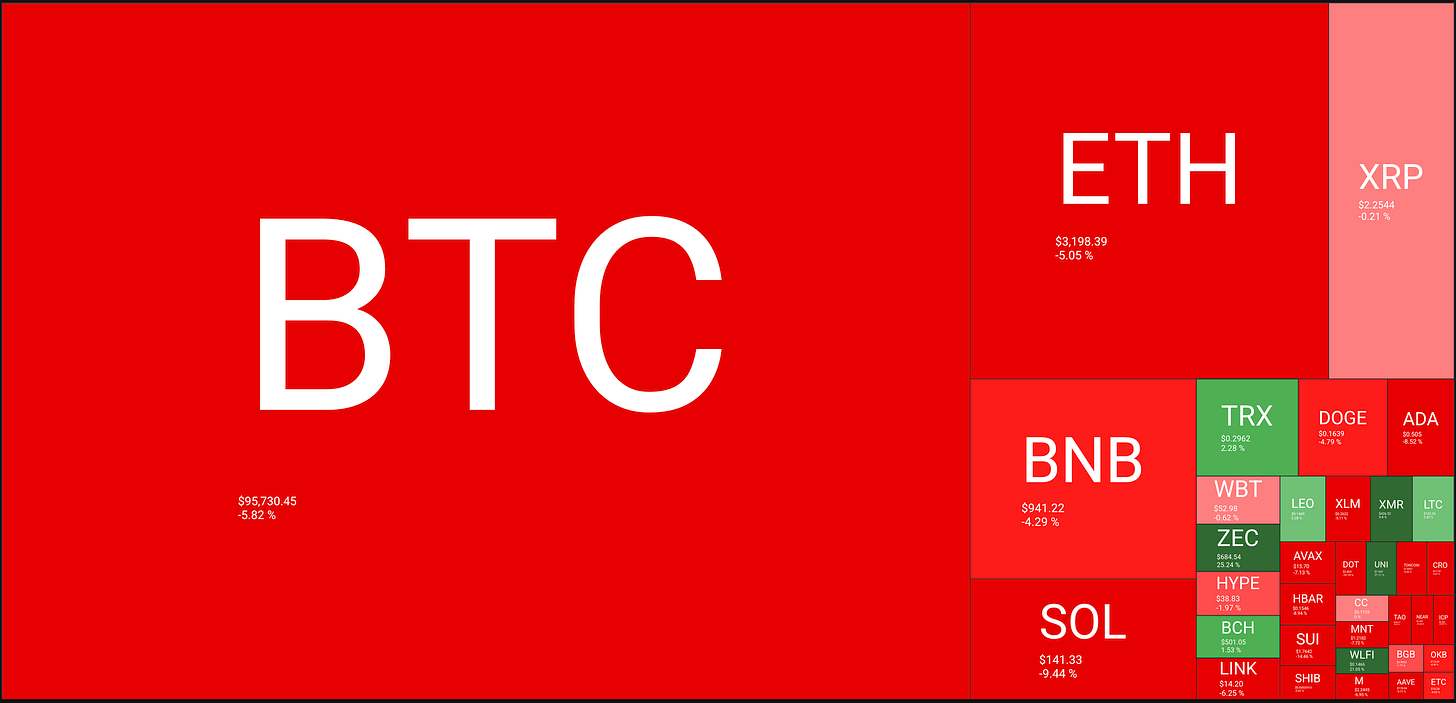Weekly Journal: UBTECH Begins World’s First Mass Delivery of Humanoid Robots
[6 min read] Your weekend guide to getting ahead on the digital frontier. UBTECH’s humanoid rollout links the metaverse to the real world by giving AI physical workers at scale.
Welcome to this week’s Weekly Journal 📔, your guide to the latest news & innovation in emerging technology, digital assets, and our exciting path to the Metaverse. This is week 153 of the 520 weeks of newsletters I have committed to, a decade of documenting our physical and digital lives converge. New subscribers are encouraged to check out the history & purpose of this newsletter as well as the archive.
- Ryan
🌐 Digital Assets Market Update
To me, the Metaverse is the convergence of physical & virtual lives. As we work, play and socialise in virtual worlds, we need virtual currencies & assets. These have now reached mainstream finance as a defined asset class:
The crypto market has fallen sharply in November, with global capitalisation dropping from $4.28 trillion to $3.27 trillion in one month. Bitcoin is now 23 percent below its all-time high, while Ethereum has slipped 36 percent as selling pressure spreads across all major assets. The Crypto Fear and Greed Index dropped to 15, placing the market in extreme fear. This reflects growing investor anxiety and increases the likelihood of more downward movement.
From a metaverse perspective, the pullback shifts attention to projects with clear utility, strong balance sheets, and durable demand. As speculative capital retreats, builders that focus on payments, digital identity, and real asset tokenisation are better placed to hold value through the current cycle.
🔥🗺️Heat map shows the 7 day change in price (red down, green up) and block size is market cap.
🎭 Crypto Fear and Greed Index is an insight into the underlying psychological forces that drive the market’s volatility. Sentiment reveals itself across various channels—from social media activity to Google search trends—and when analysed alongside market data, these signals provide meaningful insight into the prevailing investment climate. The Fear & Greed Index aggregates these inputs, assigning weighted value to each, and distils them into a single, unified score.
🗞️ Metaverse news from this week:
UBTECH has started large-scale deliveries of its Walker S2 humanoid robots, shipping hundreds of units from Shenzhen to active industrial sites. Orders for the robots have now passed 800 million yuan as Chinese automakers, logistics firms, and major tech companies move to automate labour-intensive factory tasks. UBTECH plans to deliver 500 units by December and says early deployments show stable performance in real factories rather than controlled labs.
A key advantage is the Walker S2’s self-swapping battery system, allowing robots to replace their own power packs in minutes. This supports continuous 24-hour operation and makes the robot suitable for long shifts involving lifting, carrying, and walking. Humanoids now account for 30 percent of UBTECH’s sales, up from 10 percent last year. Strong financial results and a rising stock price have reinforced investor confidence, with analysts expecting further gains.
From a metaverse perspective, this marks an important shift as physical robotics begins to scale in parallel with digital autonomy. Humanoids like the Walker S2 can act as real-world agents for AI systems, linking virtual decision making with physical outcomes. The emerging pattern is clear: AI models shape behaviour in the metaverse and robots execute those behaviours in factories, warehouses, and public spaces.
📖 Read of the week: US Stablecoin Power-Play Could Epically Backfire
🗞 Financial Times | November 2025
Washington’s new belief that dollar stablecoins can extend US monetary dominance is gathering momentum. David Sacks and Stephen Miran argue that exporting privately issued, fully backed digital dollars will deepen global demand for Treasuries, lower long-term interest rates, and give the Fed more room to ease policy.
The numbers look compelling: stablecoin usage could hit US $3 trillion by 2030, potentially reducing US rates by up to 40 bps and funnelling foreign capital into American markets.
But the FT highlights the historical pattern: dollarisation always provokes resistance. Countries consistently defend their monetary sovereignty, improve domestic institutions, and roll back dollar dependence when the costs begin to bite. Digital dollars are unlikely to escape this cycle.
Worse, the push for a global “stablecoin glut” could catalyse coordination among nations frustrated with US monetary influence — reviving interest in supranational alternatives such as enhanced IMF SDRs. Instead of entrenching the dollar, aggressive stablecoin expansion could accelerate the search for a genuine counterweight to it.
🔗 Why it matters for the Metaverse
The metaverse will operate on interoperable digital money, not legacy banking rails. If the US overplays its hand, we may see a splintering of digital-currency zones across virtual worlds — American stablecoin realms, Asian settlement systems, and SDR-style multilateral tokens emerging as neutral money for AI agents, digital twins, and virtual-economy trade.
In short, monetary geopolitics will shape metaverse geopolitics. The currencies that dominate tomorrow’s virtual economies may not mirror those ruling today’s physical ones.
🎥 Watch of the week:
AI Spotlight 🎨🤖🎵✍🏼: Project Gecko and the Push for Truly Inclusive AI
In the Metaverse, AI will be critical for creating intelligent virtual environments and avatars that can understand and respond to users with human-like cognition and natural interactions.
Microsoft’s new Project Gecko is one of the most significant developments in the AI world this year because it tackles a problem most people never see. AI tools work brilliantly in places with powerful devices, strong connectivity and a dominance of English. They work far less well for the billions of people who live outside that bubble. Project Gecko is Microsoft’s attempt to fix that imbalance by building AI that starts with local languages, local culture and the real conditions of everyday life across the Global South.
The project brings together researchers in Africa, India and the United States to create AI systems that are not only accurate but culturally grounded. Rather than translating English answers into Swahili or Hindi, these systems begin by learning directly from local contexts. They are also built to run on low cost devices and slow networks, which is essential for communities where most people use basic Android phones and limited mobile data. To support this, the team works with smaller language models that can operate on cheaper hardware without losing relevance or clarity.
At the heart of the project is a new system called MMCTAgent, which can understand speech, images and video, and then respond with step by step, locally appropriate guidance. This matters because it changes the nature of AI from a tool that simply predicts likely sentences to one that can reason with context. The first major application is for farmers in India and Kenya, who can now speak naturally into their phone and receive practical advice in their own language. Field trials show higher accuracy, better ease of use and significantly more trust from the farmers compared to standard AI systems.
Project Gecko also has important implications for the future of the metaverse. If the next generation of digital spaces is to be truly global, it cannot be shaped only by English speaking, high income cultures. A metaverse that feels natural and accessible for everyone must start with linguistically and culturally grounded AI. Gecko lays the groundwork for this by showing how digital agents can operate inside local worldviews rather than forcing users to adopt Western defaults. It points toward a future where a farmer in rural Kenya can access immersive advice in Kikamba, or where small retailers in Bihar can use local language AI assistants inside lightweight spatial interfaces.
This approach also aligns with growing global attention to indigenous data sovereignty and national AI policies that put cultural identity at the centre. It suggests that AI’s next phase will be far more plural, far more diverse and far more reflective of the realities of everyday life across the world. Project Gecko is not flashy, but it signals an important shift. AI is becoming not only larger and more powerful, but also more grounded and more inclusive.
In short, Project Gecko shows that the future of AI will not be built in one language or one culture. It will be shaped by the voices and experiences of the global majority, and that shift will influence everything from everyday mobile tools to the wider metaverse that is slowly emerging.
That’s all for this week! If you have any organisations in mind that could benefit from keynotes about emerging technology, be sure to reach out. Public speaking is one of many services I offer.



